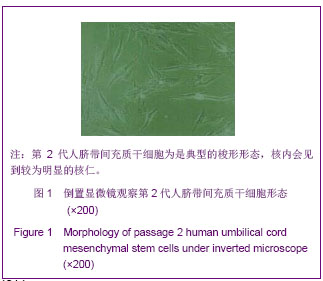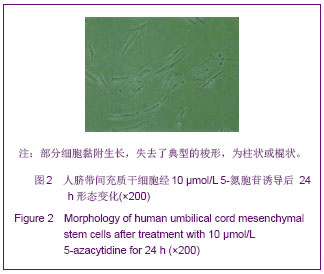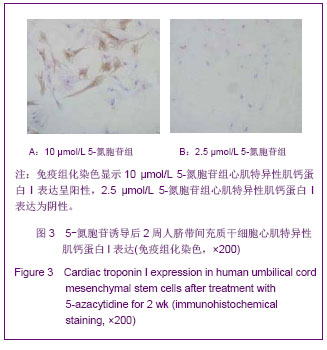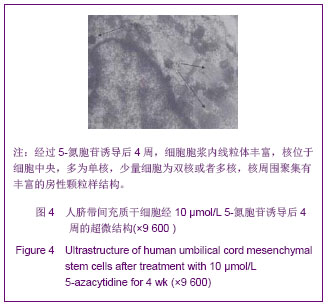中国组织工程研究 ›› 2013, Vol. 17 ›› Issue (23): 4212-4215.doi: 10.3969/j.issn.2095-4344.2013.23.005
• 脐带脐血干细胞 umbilical cord blood stem cells • 上一篇 下一篇
人脐带间充质干细胞经5-氮胞苷诱导后心肌特异性肌钙蛋白I的表达
唐 欣1,王妮妮1,易海波2,王 岩3,庞天舒1
- 1辽河油田中心医院循环内科,辽宁省盘锦市 124000
2辽河油田第二职工医院内科,辽宁省盘锦市 124000
3辽河油田中心医院放射线科,辽宁省盘锦市 124000
Cardiac troponin I expression in human umbilical cord mesenchymal stem cells after 5-azacytidine induction in vitro
Tang Xin1, Wang Ni-ni1 , Yi Hai-bo2 , Wang Yan3 , Pang Tian-shu1
- 1 Department of Cardiology, Central Hospital of Liaohe Oil Field, Panjin 124000, Liaoning Province, China
2 Department of Internal Medicine, Second Workers Hospital of Liaohe Oil Field, Panjin 124000, Liaoning Province, China
3 Department of Radiology, Central Hospital of Liaohe Oil Field, Panjin 124000, Liaoning Province, China
摘要:
背景:人脐带间充质干细胞具有多向分化潜能,经诱导后是否可向心肌细胞分化?目前的报道尚不多。 目的:观察人脐带间充质干细胞经5-氮胞苷诱导分化后肌钙蛋白I的表达情况。 方法:取第2代人脐带间充质干细胞标本,经消化、离心、沉淀后,分为7份,制成细胞悬液,调整细胞浓度为2×107 L-1,分别加入浓度为80,40,20,10,5,2.5,0 μmol/L 5-氮胞苷于同样条件继续培养,作用24 h后除去,继续培养4周。 结果与结论:①人脐带间充质干细胞经5-氮胞苷处理24 h之后,各组细胞都会出现部分死亡,失去典型的梭形形态,成为棍状或者柱状,40,80 μmol/L组细胞形态变化明显。②免疫组化染色显示5,10,20,40,80 μmol/L组诱导后2周心肌特异性肌钙蛋白I表达呈阳性,对照组与2.5 μmol/L组心肌特异性肌钙蛋白I表达为阴性。选取5个高倍视野进行细胞计数,80,40,20,10 μmol/L组间心肌样细胞的转化率差异无显著性意义,均明显高于5 μmol/L组(P < 0.05)。③超微结构观察显示经5-氮胞苷诱导后4周时部分人脐带间充质干细胞内可见典型的肌小节及心房颗粒。而未经5-氮胞苷诱导的对照组无以上改变。结果提示经5-氮胞苷诱导后人脐带间充质干细胞能够向心肌样细胞转化。
中图分类号:



